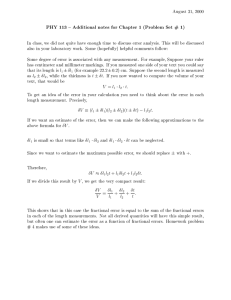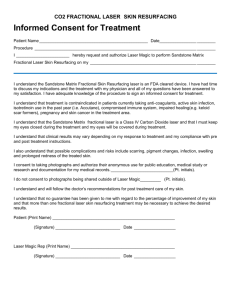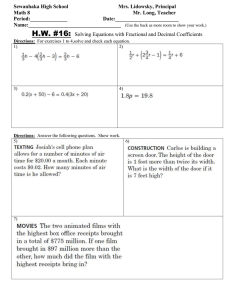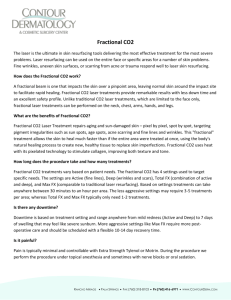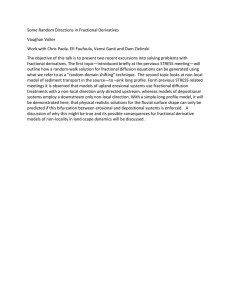ablative fractional resurfacing
advertisement
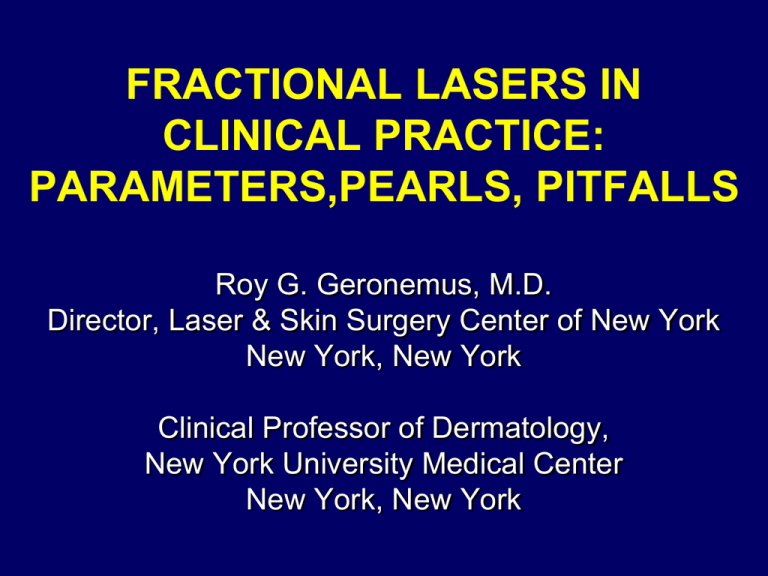
FRACTIONAL LASERS IN CLINICAL PRACTICE: PARAMETERS,PEARLS, PITFALLS Roy G. Geronemus, M.D. Director, Laser & Skin Surgery Center of New York New York, New York Clinical Professor of Dermatology, New York University Medical Center New York, New York DISCLOSURES Medical Advisory Board Zeltiq Syneron / Candela Cynosure Valeant / Medicis / Allergan Investigator Syneron / Candela Cynosure Cutera Valeant / Medicis / Allergan Dusa Myoscience MoMelan Neothetics / Lithera Kythera Miramar Cytrellis Ulthera Merz Zeltiq New York Stem Cell Foundation Stockholder Zeltiq OnLight Sciences NON-FRACTIONAL ABLATIVE CO2 LASER SIDE EFFECTS OF LASER RESURFACING Symptom % Patients (n=104) Duration Hyperpigmentation 2.8 1.5 months Hypopigmentation 16.3 3-10 weeks onset Hypersensitivity 4.8 1.5 months Scarring 0 N/A Infection 0 N/A Bernstein LJ, Kauvar ANB, Grossman MC, Geronemus RG Dermatol Surg 1998 FULLY ABLATIVE CO2 LASER (NON-FRACTIONAL) FULLY ABLATIVE CO2 LASER (NON-FRACTIONAL) FULLY ABLATIVE CO2 LASER (NON-FRACTIONAL) Scarring post CO2 resurfacing “MYCOBACTERIUM CHELONAE INFECTION AFTER FRACTIONATED CARBON DIOXIDE FACIAL RESURFACING (PRESENTING AS AN ATYPICALACNEIFORM ERUPTION): CASE REPORT AND LITERATURE REVIEW” Palm MD, Butterwick KJ, Goldman MP Dermatol Surg. 2010 Sep;36(9):1473-81 FRACTIONAL LASER TREATMENT ~100 µm Healing occurs from viable tissue Zones of spared tissue contain clusters of epidermal stem cells and Transit Amplifying (TA) cells Dermis SubQ FRACTIONAL LASER TREATMENT Human Tissue – Cross Section Results: Complete reepithelialization in 24 hrs. Clear collagen denaturation from papillary dermis into mid reticular dermis Healing occurs from viable tissue. Zones of spared tissue contain clusters of epidermal stem cells and Transit Amplifying (TA) cells Microscopic Epidermal Necrotic Debris (MEND) Controlled Zones of Denatured Collagen in the Dermis In Vivo Histology (16 days post exposure) NON-ABLATIVE FRACTIONAL (FRACTIONATED) LASERS / LIGHT SOURCES DEVICE WAVELENGTH SPOT SIZES INJURY DEPTH Fraxel SR 1550 Dual 1550 nm, 1927 nm Fiber laser Telescopic variability 1.114 mm Lux 1540 1540 nm laser 10 mm – 15 mm 750 microns Affirm 1440 nm laser and xenon pulsed light Up to 10 mm 100 – 300 microns Clear & Brilliant Permea 1440 nm 1927 nm 15mm 15mm 580-1359 microns 190-200 Microns Emerge 1410 nm 12x18 450 microns THULIUM FIBER LASER (1927NM) HISTOLOGY 20 mJ 5 mJ 5 mJ 10 mJ 15 mJ 20 mJ HISTOLOGY COMPARISON Pearl Fractional (YSGG) Histology courtesy of Brian Biesman, MD SmartXide DOT (CO2) Fraxel Re:pair (CO2) SMARTXIDE HISTOLOGY • ~150 micron ablation (left image) • ~300 micron ablation (right image with 3 stacked pulses) • ~250 microns bottom coag • ~200 microns edge coag YSGG HISTOLOGY • 600 micron ablation • 60 microns bottom coag • 40 microns edge coag FRAXEL HISTOLOGY • ~up to 1.5 mm ablation • ~200 microns bottom coag • ~70 microns edge coag ANNULAR COAGULATION OF DERMAL COLLAGEN 100 mm 100 mm Cross-polarized image HEALING SUMMARY FOLLOWING FRAXEL RE:PAIR® TREATMENT (MULTIPLE SUBJECTS) 3 months Immediately 48 hours 100 mm 100 mm 7 days 100 mm 1 month 100 mm With the 135 micron Spot Size handpiece 100 mm ABLATIVE FRACTIONAL DEVICES • Diversity of laser systems • Differences include: • Wavelength • Delivery method – stamped vs. scanning • Depth of ablation • Extent of thermal injury • Speed of treatment FRACTIONAL ABLATIVE DEVICES FRACTIONAL DEVICE WAVELENGTH APPROX LESION DEPTH SPOT SIZE DELIVERY SYSTEM DENSITY/ COVERAGE MESSAGING Fraxel re:pair 10600 nm Full control of depth up to 1600 µm (at 70 mJ) Fixed Continuous motion optical tracking system 5 – 70% *No reported cases of delayed onset hypopigmentation after more than 500 treatments and over 2.5 years of patient follow ups. *Treat with broadest range of parameters up to 4 times faster than any other ablative fractional device; superficial to deep (5-70mJ), mild to aggressive (5-70%) all in a single handpiece. *FDA cleared for wrinkles, rhytides, textural irregularities, vascular dyschromia and pigmented lesions). *Integrated smoke evacuator eliminates the need for staff support. < 200 µm Lumenis Bridge Therapy (Active FX and Deep FX) 10600 nm Active FX Variable Deep FX – unknown Fixed – 1.3mm for Active FX 120 µm for Deep FX Scanning stamp pattern 55-100% coverage w/Active FX 5-50% coverage w/Deep FX *CO2 is still the gold standard and now w/the Bridge Therapy you can bridge the gap between deep and shallow treatment. *< 10 min for full face treatment. *Single pass Sciton ProFractional 2940 nm 20-1500 µm 250 microns Scanning stamp pattern (up to 20mm X 20mm) 1.5-60% coverage *Single pass, fewer treatments, painless, fast recovery, no consumables FRACTIONAL ABLATIVE DEVICES FRACTIONA L DEVICE WAVELENGTH APPROX LESION DEPTH SPOT SIZE DELIVERY SYSTEM DENSITY/ COVERA GE Lasering Mixto SX 10600 nm 20-500 µm 300 µm Stamping 20% fixed Deka SmartXide 10600 nm Unknown 100 µm – 1 mm Scanning stamp pattern (Scan area: Min 1x4 mm Max 18x18 mm) Cutera Pearl 2790 nm 80 µm Fixed – 6 mm Scanning stamp Alma Pixel 2940 nm 30-60 µm Fixed – 1.1 mm 11x11 mm w/49 or 81 pixels in that square spot area Scanning stamp pattern CO2RE 10,600 nm 30-1060 µm Scanning stamp pattern MESSAGING *20 min procedure *No topical or cooling *Fast recovery *Reliable *Safe *Controllable depth penetration *Results in 1-2 treatments and less overall downtime than other technologies *The leader in expandable, multiapplication technology (Harmony Platform) NON-ABLATIVE AND ABLATIVE • • • • • • • • • • NON-ABLATIVE Rejuvenation Pore size Fine lines Acne scars Surgical scars Actinic Keratosis Mild to moderate tightening Dyschromia Striae Melasma • • • • • • • • ABLATIVE Rejuvenation Pore size Fine lines Acne scars Surgical scars Moderate tightening Deeper lines Some dyschromia • Festoons CLEAR ADVANTAGES • • • • • NON-ABLATIVE Actinic Keratosis (1927nm) Actinic Chelitis (1927nm) Diffuse photodamage (1927nm) Off the face Pore Size • • • • • • • • • ABLATIVE Tightening Atrophic scars Surgical scars Vertical lip lines Deeper rhytides Cosmetic tattoos Festoons Eyelid lifting Facilitate healing with tattoo removal POST-OP COMPARISON 1 Day Post CO2 1 Day Post Non-Ablative Fractional FRACTIONAL PHOTOTHERMOLYSIS Non-Ablative Fractional-1550nm 70mJ-40% density FRACTIONAL PHOTOTHERMOLYSIS Non-Ablative Fractional 1550nm 70mJ-40% density FRACTIONAL PHOTOTHERMOLYSIS Non-Ablative Fractional 1550nm LOWER EYELID TIGHTENING 40mJ - 30% density FRACTIONAL PHOTOTHERMOLYSIS Non-Ablative Fractional 1550nm - EYELID LIFTING 40mJ-30% density FRACTIONAL PHOTOTHERMOLYSIS Non-Ablative Fractional 1550nm – EYELID LIFTING 40mJ-30% density “EYELID TIGHTENING AND IMPROVED EYELID APERTURE THROUGH NONABLATIVE FRACTIONAL RESURFACING” Laser & Skin Surgery Center of New York Dermatol Surg 2008; 34:1454-58 “EYELID TIGHTENING AND EYELID APERTURE THROUGH NONABLATIVE FRACTIONAL RESURFACING” LASER & SKIN SURGERY CENTER OF NEW YORK Dermatol Surg 2008; 34:1454-58 Patient Percentile Degree of Improvement 28% 1% - 25% improvement 26.9% 25% - 50% improvement 25.8% 50% - 75% improvement 19.4% 75% - 100% improvement *Scarring, hypopigmentation, hyperpigmentation, persistent erythema and post operative wounding were not observed. FRACTIONAL PHOTOTHERMOLYSIS Non-Ablative Fractional 1550nm – ACNE SCARRING 70mJ-35% density PRIMOS • Measures surface topography of the skin and can be used to follow depth of acne scars over the course of treatment • Measures a 30 by 30 mm area of skin • Sensitive and reproducible Primos Evaluation of 60 Acne Scars treated with the Fraxel laser Average Quantitative Improvement – 50% FRACTIONAL PHOTOTHERMOLYSIS Non-Ablative Fractional 1550nm – HYPOPIGMENTATION 70mJ-35% density FRACTIONAL PHOTOTHERMOLYSIS Non-Ablative Fractional 1550 NM 70mJ-35% density “THE SAFETY AND EFFICACY OF FRACTIONAL PHOTOTHERMOLYSIS FOR CORRECTION OF STRIAE DISTENSAE” Laser & Skin Surgery Center of New York Journal of Drugs in Dermatology September 2008; 7:857-61 STUDY DESIGN • 20 female patients with atrophic mature striae distensae • Ages: 18-59 years • Skin phototypes: I-VI • Treatment sites: abdomen, breast, hips, and buttocks • Laser: 1550 nm, 12-18 mJ, 250 mtz/cm2 (microthermal zone density), 8 passes for a total of 2000 MTZ/cm2, 15 mm laser aperture with cold air cooling of skin surface RESULTS • 18 of 20 patients completed study to 3 months, 11 patients returned for 6 month follow up • Photographic analysis: • 3 objective observers • Mean: 2.44 (0-4 scale) corresponding to ~ 36% at 3 mo • Mean: 2.33 (0-4 scale) corresponding to ~ 33% at 6 mo • Pt subjective evaluations: • Mean: 2.76 (0-4 scale) corresponding to ~ 43% • 12/18 patients with > 50% improvement • 6/18 patients note > 75% improvement • Histology: • Pre and 3 month post treatment histology without significant change. (Small sample size and taken from 2 patients with the smallest noted change for both subjective and objective measurements) FRACTIONAL PHOTOTHERMOLYSIS Pre Tx Rated as 75% improvement 3 mo Post Tx Non-Ablative Fractional 1550nm 70mJ-35% density FRACTIONAL PHOTOTHERMOLYSIS Pre Treatment 6 month Post Treatment NON-ABLATIVE FRACTIONAL 1550nm 70mJ-35% density “SIDE EFFECTS AND COMPLICATIONS OF FRACTIONAL LASER PHOTOTHERMOLYSIS: EXPERIENCE WITH 961 TREATMENTS” GRABER E, TANZI E, ALSTER T. DERM SURG. VOL 34 ISSUE 3, PAGES 301-307 • • • • • 961 treatments 7.6% resulted in development of complications 1.87% were acneiform eruptions 1.77% were herpes simplex virus outbreaks PIH in darker skin types THULIUM 1927NM NON-ABLATIVE Bronzing Erythema 1927 NM THULIUM LASER • 1927 nm Fractionated Thulium Laser (Fraxel Dual, Solta Medical, Hayward, CA) • Fluence of 5-20 mJ, coverage 0-70% • Moderate to high water absorption • Ideal for superficial resurfacing Courtesy of Laser & Skin Surgery Center of New York® “1927-NM FRACTIONAL RESURFACING OF FACIAL ACTINIC KERATOSES: A PROMISING NEW THERAPEUTIC OPTION” Laser & Skin Surgery Center of New York J Am Acad Dermatol. 2013 Jan;68(1):98-102 AK CLEARANCE DURING TREATMENT PHASE Percentage Clearance of AK’s Post 1st treatment N=10 62.7% (Range 16.6-100%) Post 2nd treatment N=5 84.3% (Range 54-100%) Post 3rd treatment N=4 88.5% (Range 54-100%) Courtesy of Laser & Skin Surgery Center of New York® AK CLEARANCE DURING FOLLOW-UP PHASE Follow-Up post Final TX Percentage Clearance of AK’s 1 month N=7 90.6% (Range 72.7-100%) 3 months N=5 84.0% (Range 71.4-100%) 6 months N=3 85.1% (Range 71.9-100%) Courtesy of Laser & Skin Surgery Center of New York® TOLERABILITY / SAFETY • Well-tolerated. • No incidents of scarring or infection • Erythema and peeling lasting 4-5 days on average. • Average Pain Score during treatment: 2.71/10 (Range 0-9) Courtesy of Laser & Skin Surgery Center of New York® THULIUM LASER 1927 NM NON-ABLATIVE Baseline 1 Month Fup 7 AK 100% Clearance 10mJ-65% density THULIUM LASER 1927 NM NON-ABLATIVE BASELINE 6 MONTH FUP 32 AK’s Courtesy of Laser & Skin Surgery Center of New York® 71.9% Clearance (9 AK’s) 10mJ-65% density THULIUM LASER 1927 NM NON-ABLATIVE Baseline 3 month F/U 74 AK Courtesy of Laser & Skin Surgery Center of New York® 83.8% Clearance (12 AK) 10mJ-65% density THULIUM LASER 1927 NM NON-ABLATIVE Courtesy of Laser & Skin Surgery Center of New York® Baseline 3 month F/U 74 AK 83.8% Clearance (12 AK) 10mJ-65% density THULIUM LASER 1927 NM NON-ABLATIVE Baseline 15 AK Courtesy of Laser & Skin Surgery Center of New York® F/U Post 2 Treatments 80% Clearance (3 AK) 10mJ-65% density THULIUM LASER 1927 NM NON-ABLATIVE Baseline F/U Post 2 Treatments 15 AK 80% Clearance (3 AK) 1927nm 10mJ-65% density THULIUM LASER 1927 NM NON-ABLATIVE Actinic Cheilitis 1927nm 10mJ-65% density THULIUM LASER 1927NM NON-ABLATIVE Actinic Cheilitis 1927nm 10mJ - 65% density THULIUM LASER 1927NM NON-ABLATIVE 10mJ-65% density THULIUM LASER 1927NM NON-ABLATIVE HYPOPIGMENTATION 10mJ-65% density THULIUM LASER 1927NM NON-ABLATIVE 10mJ-65% density THULIUM LASER 1927NM NON-ABLATIVE Hypopigmentation 10mJ-65% density THULIUM LASER 1927NM NON-ABLATIVE ENLARGED PORES 10mJ-65% density CONVENTIONAL VS. LOW DENSITY FRACTIONAL Category/ Characteristic CLEAR + BRILLIANTTM Fraxel® DUAL 1550/1927 Laser System Laser Classification Class III-R Class IV Wavelength Pulse Duration 1440 (+/- 20) nm 1927 (+/- 10) nm Perméa 1440nm: 3 Watts (Nominal) 1927nm: 1 Watt (Nominal) < 5 ms Micro-Beam Spot Size 110 - 180 μm Micro-Beam Spot Energy 1440nm: 4 - 9 mJ 1927nm: 5 mJ Treatment Density 1440nm: 40–50 MTZs per cm2 per pass 1927nm: 17–34 MTZs per cm2 per pass Treatment Coverage Treatment Width 1440nm: Approximately 4% to 9% 1927nm: Approximately 5% to 10% 10 mm 1927 (+/- 10) nm 1550 (+/- 10) nm 1927nm: 10 Watts (Nominal) 1550nm: 30 Watts (Nominal) 1927nm: < 10 ms 1550nm: < 10 ms 1927nm: 256 – 620 μm 1550nm: 120 – 362 μm 1927nm: 5 – 20 mJ 1550nm: 4 – 70 mJ Dependent on selected Treatment Level and #Passes 1927nm: 20% to 70% 1550nm: 5% to 48% 7 mm and 15 mm Total Energy Delivered per Full Face Treatment (300 cm2 area) 1440nm: < 0.864 kJ 1927nm: <0.410 kJ 1927nm: < 13 kJ 1550nm: < 44 kJ Lesion Width 1440nm: 120 - 202 μm 1927nm: 221 μm 1440nm: 282 - 384 μm 1927nm: 167 μm 1927nm: 233 – 465 μm 1550nm: 84 – 353 μm 1927nm: 192 – 202 μm 1550nm: 382 – 1359 μm Peak Laser Power Lesion Depth Courtesy of Solta Medical EMERGE VS. ICON 1540 Wavelength Treatment Window Fluence/Energy µC Diameter Pitch Density of µC Pulse Width Depth of Penetration Delivery Modes Emerge Icon 1540 1410 nm 1540nm 12mm x 8mm XD 12 x12 mm XF 15mm round 10 mj to 30 mj XD 30 to 70 mJ/mb XF 6 to 60 mJ/mb Up to 350µ 0.9 mm to 3.5 mm 11 to 123 µc per cm2 XD up to 230µ XF up to 270µ XD 2mm XF 1mm XD 22 mb/cm2 XF 115 mb/cm2 Max 20 ms 10-20ms 450µ XD 1060µ XF 750µ 3 modes Stamping, tile cascade PIGMENT REMOVAL IN MENDS untreated 0 days large amount of melanin in MEND 3days 14 days Results: Outward migration of melanin in the MENDs 3 days after treatment LOW DENSITY LOW ENERGY FRACTIONAL LOW ENERGY LOW DENSITY 1927 NM 7mJ-10% density LOW ENERGY LOW DENSITY 1927 NM 7mJ-10% density LOW ENERGY LOW DENSITY 1927 NM 7mJ-10% density LOW ENERGY LOW DENSITY 1927 NM 7mJ-10% density LOW ENERGY LOW DENSITY 1927 NM 7mJ-10% density LOW ENERGY LOW DENSITY 1927 NM 7mJ-10% density LOW ENERGY LOW DENSITY 1927 NM LASER ASSISTED DRUG DELIVERY PIH 7mJ-10% density ABLATIVE FRACTIONAL RESURFACING Anesthesia Requirements: • Topical • Local • Regional • IV sedation • General FULL FACE PROTOCOL – ANESTHESIA FOR MODERATE TO AGGRESSIVE TREATMENTS • Topical • Regional nerve block • IM Toradol • Forced air cooling • IV sedation RAPID HEALING PROGRESSION ABLATIVE FRACTIONAL RESURFACING Before Day 1 Day 4 Photographs Courtesy of Deb Atkin, M.D Day 2 Day 5 Day 3 Day 6 ABLATIVE FRACTIONAL RESURFACING FRAXEL RE:PAIR Courtesy of Roy G. Geronemus, M.D. 70mJ-50% density ABLATIVE FRACTIONAL RESURFACING FRAXEL RE:PAIR Courtesy of Roy G. Geronemus, M.D. 70mJ-50% density ABLATIVE FRACTIONAL RESURFACING FRAXEL RE:PAIR LOWER EYELID 30mJ-40% density ABLATIVE FRACTIONAL RESURFACING FRAXEL RE:PAIR Courtesy of Roy G. Geronemus, M.D. 30mJ-30% density ABLATIVE FRACTIONAL RESURFACING FRAXEL RE:PAIR 3 month follow up Pre-Tx 30mJ-30% density Courtesy of Roy G. Geronemus, M.D. ABLATIVE FRACTIONAL RESURFACING FRAXEL RE:PAIR 70mJ-50% density Courtesy of Roy G. Geronemus, M.D. ABLATIVE FRACTIONAL RESURFACING FRAXEL RE:PAIR 70mJ-50% density Courtesy of Roy G. Geronemus, M.D. ABLATIVE FRACTIONAL RESURFACING FRAXEL RE:PAIR 70mJ-50% density Courtesy of Roy G. Geronemus, M.D. ABLATIVE FRACTIONAL RESURFACING FRAXEL RE:PAIR 70mJ-50% density Courtesy of Roy G. Geronemus, M.D. ABLATIVE FRACTIONAL RESURFACING FRAXEL RE:PAIR 70mJ-50% density Courtesy of Roy G. Geronemus, M.D. ABLATIVE FRACTIONAL RESURFACING FRAXEL RE:PAIR Pre Treatment Post Treatment 1 70mJ-50% density - 1 PASS ONLY Courtesy of Roy G. Geronemus, M.D. LASER & SKIN SURGERY CENTER OF NEW YORK “SUCCESSFUL TREATMENT OF ACNEIFORM SCARRING WITH CO2 ABLATIVE FRACTIONAL RESURFACING” LASERS IN SURGERY AND MEDICINE. Volume 40, Issue 6, p. 381-6. August 2008. ABLATIVE FRACTIONAL RESURFACING Acne Scarring 70mJ-50% density ABLATIVE FRACTIONAL RESURFACING 70mJ-50% density Acne Scarring LASER & SKIN SURGERY CENTER OF NEW YORK “SUCCESSFUL TREATMENT OF ACNEIFORM SCARRING WITH CO2 ABLATIVE FRACTIONAL RESURFACING” LASERS IN SURGERY AND MEDICINE. Volume 40, Issue 6, p. 381-6. August 2008. FRAXEL RE:PAIR – ACNE SCARS 1 month post procedure Subject assessment 1 month post procedure Investigator assessment 3 months post procedure Subject assessment 3 months post procedure Investigator assessment Texture 1.75 1.92 2.27 2.39 Atrophy 1.42 1.75 2.11 2.19 Overall Satisfaction 1.5 1.83 2.42 2.46 LASER & SKIN SURGERY CENTER OF NEW YORK “SUCCESSFUL TREATMENT OF ACNEIFORM SCARRING WITH CO2 ABLATIVE FRACTIONAL RESURFACING” LASERS IN SURGERY AND MEDICINE. Volume 40, Issue 6, p. 381-6. August 2008. FRAXEL RE:PAIR – ACNE SCARS Scar 1 2 3 4 5 6 7 8 9 10 Mean % Overall Change from Baseline 47.6% 57.9% 76.7% 71.0% 43.3% 68.9% 73.7% 76.5% 79.9% 72.2% 68.8% “SUCCESSFUL TREATMENT OF ATROPHIC POSTOPERATIVE AND TRAUMATIC SCARRING WITH CARBON DIOXIDE ABLATIVE FRACTIONAL RESURFACING” Laser & Skin Surgery Center of New York Arch Dermatol. 2010;146(2):133-140 ABLATIVE FRACTIONAL RESURFACING Courtesy of Roy G. Geronemus, M.D. Pre tx 1 1 week post tx 1 1 month post tx 1/ Pre tx 2 1 month post tx 2 1 week post tx 2 70mJ-50% density Courtesy of Roy G. Geronemus, M.D. ABLATIVE FRACTIONAL RESURFACING 70mJ-60% density ABLATIVE FRACTIONAL RESURFACING 70mJ-60% density Courtesy of Roy G. Geronemus, M.D. SURGICAL SCAR LEFT CHEEK Pre Tx 1 40mJ-50% density 6 Month Post 3 AFR Baseline Surgical Scar 1A Baseline Scar Volume= 11.38mm3 1B 1 A. Baseline photograph of surgical scar (dotted black line). 1B. Baseline topographical image of surgical scar (solid red line). Dark red color is reference plane. Green areas represent depressions, and blue areas represent areas of greatest depression. Surgical Scar 6 Months Post Final Treatment 2A Scar Volume 6 Months Post Final Treatment= 4.84mm3 2B Volume Improvement= 57.5% Max Depth Improvement= 36.3% 2A. Surgical scar (dotted line) 6 months post 3 AFR treatments. 2B. Topographical image of surgical scar (solid red line) 6 months post 3 AFR treatments. The decrease in both green & blue areas within red line represents a 57.5% reduction in scar volume & 36.3% reduction in max depth SURGICAL SCAR LEFT UPPER LIP Pre Tx 1 3 Month Post Tx 3 70mJ-50% density ABLATIVE FRACTIONAL RESURFACING COURTESY OF LASER & SKIN SURGERY CENTER OF NY 70mJ-50% density ABLATIVE FRACTIONAL RESURFACING SURGICAL SCARS 70mJ-50% density ABLATIVE FRACTIONAL RESURFACING FULL THICKNESS SKIN GRAFT 40 mJ - 0.1 KJ ABLATIVE FRACTIONAL RESURFACING 40 mJ - 40% density ABLATIVE FRACTIONAL RESURFACING 70 mJ - 50% density ABLATIVE FRACTIONAL RESURFACING 30 mJ - 30% density ABLATIVE FRACTIONAL RESURFACING SCAR 60 mJ - 40% density ABLATIVE FRACTIONAL RESURFACING Scars-Type IV V 30 mJ - 40% density ABLATIVE FRACTIONAL RESURFACING Active Fx 30 mJ - 100W “FRACTIONAL CO2 LASERASSISTED DRUG DELIVERY” MERETE HAEDERSDAL MD, PHD, DMSC, FERNANDA H. SAKAMOTO MD, WILLIAM A. FARINELLI BA, APOSTOLOS G. DOUKAS PHD, JOSH TAM PHD, AND R. ROX ANDERSON MD Lasers Surg Med 2010 Feb;42(2):113-22. “COMPLICATIONS OF FRACTIONAL CO2 LASER RESURFACING: FOUR CASES” FIFE D, FITZPATRICK R, ZACHARY C Lasers in Surgery and Medicine 41:179-184 (2009) Photo courtesy of Christopher Zachary, M.D. “DYSTROPHIC CALCIFICATION AND ACCENTUATED LOCALIZED ARGYRIA AFTER FRACTIONATED CARBON DIOXIDE LASER THERAPY OF HYPERTROPHIC SCARS” AMANDA R. SHAUB, MD; PATRICK J. BROWN, MD; TODD T. KOBAYASHI, MD; MICHAEL R. LEWIN, MD; CHAD M. HIVNOR, MD JAMA Dermatol 2014 Mar 1;150(3):312-641:179-184 A PICOSECOND 755NM LASER WITH DIFFRACTIVE LENS ARRAY FOR SCARRING AND REJUVENATION • The diffractive lens array is a specialized optic that delivers varying levels of heat at a fixed spot size and fluence • 70% of the fluence is delivered by high energy pulses that are 500 microns apart • Lower level heating surrounds these defined areas of higher level pulses “UTILIZATION OF A PICOSECOND PULSE DURATION LASER WITH SPECIALIZED OPTIC FOR TREATMENT OF FACIAL ACNE SCARRING” BRAUER JA, KAZLOUSKAYA V, ALABDULRAZZAQ H, BAE YS, BERNSTEIN LJ, ANOLIK R, HELLER PA, GERONEMUS RG JAMA Dermatol 2015 Mar 1;151(3):278-284 REJUVENATION WITH PICOSECEOND LASERS FOCUS™ LENS ARRAY • • • Closely packed array of diffractive lenses to focus, and redistribute each pulse Concentrates energy into hundreds of micro-spots Fluence within each micro-spot magnified up to 20X that of a standard pulse Baseline One month after six treatments ACNE SCARRING / FOCUS Pre Treatment 1 Before Roy Geronemus, MD 3 Month Post treatment 7 After ACNE SCARRING / FOCUS Pre Treatment 1 Before Roy Geronemus, MD 3 Month Post treatment 7 After ACNE SCARRING FOCUS, 6MM, 0.71J/CM2 8 Tx, 3 mo. Follow up Roy Geronemus, MD Before After Courtesy of David McDaniel, M.D. FRACTIONAL BIPOLAR RADIOFREQUENCY MATRIX RF SYNERON Bipolar radiofrequency 64 pin tip 144 pin tip Tunable program COMPARISON OF FRACTIONAL TECHNOLOGY Er-Glass 1550/40nm Thulium 1927nm CO2 10600nm Resurfacing Resurfacing Resurfacing Re:Store Lux 1540nm Re:Store Dual ActiveFX /DeepFX, Re:Pair Bi-PolarRF (1MHZ) Matrix RF MATRIX RF Skin Impact At Various Time Stages 5 Days Post Tx 2 Days Post Tx MATRIX RF 64 PIN TIP Program A Histology Program B Program C Program C MATRIX RF Baseline Lori Brightman, MD Laser & Skin Surgery Center of New York 1 month post Tx # 2 6 week post tx #3 HIGH INTENSITY FOCUSED RF HOW DOES IT WORK? 1 TREATMENT CREATES 50,000 PLUS MICROCOAGULATION ZONES Diagram of RF (+) / (-) electrodes inside of 49 needle tip RF (-) RF (+) INFINI HIGH INTENSITY FOCUSED RF • Fractional coagulation of dermis or subdermis • Temperatures high enough for coagulation – maximum tightening effects – • Physical effect on fibroblasts – stretching by the microneedles leads to further collagen remodeling • No skin cooling needed, very little pigmentation risk • Can treat all Skin Types I - VI OVER 3.5 MM DEEP TREATMENT ZONES 1.5 mm 0.5 mm 1.0 mm 2.0 mm Needle depths of from 0.5 mm to 3.5 mm are illustrated at a constant power level of 4 and an exposure time of 100 ms. Courtesy of BC Leo Goo, Dermatologist, S.Korea 3.5 mm INFINI – ACNE SCAR TREATMENT 4 months after last procedure – 3 procedures – 3 passes in each procedure – interval of 4 weeks between procedures Courtesy of Gilly Munavalli, MD, NC


